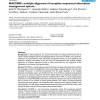9 search results - page 1 / 2 » Linear predictive coding representation of correlated mutati... |
CIKM
2009
Springer
13 years 11 months ago
2009
Springer
Background: Although both conservation and correlated mutation (CM) are important information reflecting the different sorts of context in multiple sequence alignment, most of ali...
WABI
2009
Springer
13 years 11 months ago
2009
Springer
Background: Frameshift mutations in protein-coding DNA sequences produce a drastic change in the resulting protein sequence, which prevents classic protein alignment methods from ...
BMCBI
2006
13 years 4 months ago
2006
Background: In the post-genomic era, systems-level studies are being performed that seek to explain complex biological systems by integrating diverse resources from fields such as...
BMCBI
2010
13 years 4 months ago
2010
Background: Protein kinases play crucial roles in cell growth, differentiation, and apoptosis. Abnormal function of protein kinases can lead to many serious diseases, such as canc...
BMCBI
2006
13 years 4 months ago
2006
Background: The majority of peptide bonds in proteins are found to occur in the trans conformation. However, for proline residues, a considerable fraction of Prolyl peptide bonds ...

